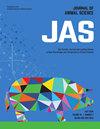Genomics of liver abscesses in feedlot cattle
IF 2.7
2区 农林科学
Q1 AGRICULTURE, DAIRY & ANIMAL SCIENCE
引用次数: 0
Abstract
The primary reason livers are condemned is due to abscesses, which are visible lesions detected on the liver during routine harvest of the animal. Condemned livers are deemed not fit for human consumption, and result in over $15M in lost income to the U.S. beef industry each year. Liver scoring is a 4-level measurement of abscess severity: 0 (no abscesses), A- (mild: 1-2 small abscesses), A (moderate: 2-4 active abscesses) and A+ (severe: 1 or more large, active abscesses). We quantified the degree to which known sources of variation, including genomic differences among animals, contribute to the incidence of liver abscesses in 1747 feedlot cattle fed a range of diets. Diets were grouped based on corn type (dry-rolled corn (DRC), high-moisture corn (HMC), DRC/HMC or steam-flaked Corn (SFC)) and byproduct (none, modified distillers grains plus solubles (MDGS), and Sweet Bran fed at 20%, 35% or 40%). A common set of SNP (n= 44,666) from the Illumina BovineSNP50 v2 and GGP Bovine 100K were used for genomic analyses. The posterior mean (posterior standard deviation) heritability estimate of liver score was 0.10 (0.05). Within-diet heritability estimates were not significantly different from zero but ranged from 0.02 (0.02) (MDGS) to 0.29 (0.32) (Sweet Bran fed at 35%). A BayesB Genome Wide Association Study with showed that liver score is a very polygenic trait with no large QTL segregating in this population. The genetic and phenotypic correlations of liver score with hot carcass weight, 12th rib fat, longissimus muscle area, or marbling score were not significantly different from zero. Results from the current study show that genomic selection for reduced liver score could be a useful tool to reduce the occurrence of liver abscesses in feedlot cattle, alongside current mitigation strategies; however, more data is needed to gain a better understanding of the genetic basis of liver score, as well as the relationship between liver score and other economically relevant traits, and potential genetic x diet interactions.求助全文
约1分钟内获得全文
求助全文
来源期刊

Journal of animal science
农林科学-奶制品与动物科学
CiteScore
4.80
自引率
12.10%
发文量
1589
审稿时长
3 months
期刊介绍:
The Journal of Animal Science (JAS) is the premier journal for animal science and serves as the leading source of new knowledge and perspective in this area. JAS publishes more than 500 fully reviewed research articles, invited reviews, technical notes, and letters to the editor each year.
Articles published in JAS encompass a broad range of research topics in animal production and fundamental aspects of genetics, nutrition, physiology, and preparation and utilization of animal products. Articles typically report research with beef cattle, companion animals, goats, horses, pigs, and sheep; however, studies involving other farm animals, aquatic and wildlife species, and laboratory animal species that address fundamental questions related to livestock and companion animal biology will be considered for publication.
 求助内容:
求助内容: 应助结果提醒方式:
应助结果提醒方式:


